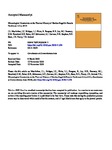Mineralogical constraints on the thermal history of martian regolith breccia Northwest Africa 8114
| dc.contributor.author | MacArthur, JL | |
| dc.contributor.author | Bridges, JC | |
| dc.contributor.author | Hicks, LJ | |
| dc.contributor.author | Burgess, R | |
| dc.contributor.author | Joy, KH | |
| dc.contributor.author | Branney, MJ | |
| dc.contributor.author | Hansford, GM | |
| dc.contributor.author | Baker, SH | |
| dc.contributor.author | Schwenzer, SP | |
| dc.contributor.author | Gurman, SJ | |
| dc.contributor.author | Stephen, Natasha | |
| dc.contributor.author | Steer, ED | |
| dc.contributor.author | Piercy, JD | |
| dc.contributor.author | Ireland, TR | |
| dc.date.accessioned | 2019-01-15T15:28:47Z | |
| dc.date.available | 2019-01-15T15:28:47Z | |
| dc.date.issued | 2019-02-01 | |
| dc.identifier.issn | 0016-7037 | |
| dc.identifier.issn | 1872-9533 | |
| dc.identifier.uri | http://hdl.handle.net/10026.1/13141 | |
| dc.description.abstract |
© 2018 The Authors Martian meteorite Northwest Africa (NWA) 8114 – a paired stone to NWA 7034 – provides an opportunity to examine the thermal history of a martian regolith and study near-surface processes and ancient environmental conditions near an impact crater on Mars. Our study reports petrographic and alteration textures and focuses on pyroxene and iron oxide grains. Some of the pyroxene clasts show exsolution lamellae, indicating a high temperature magmatic origin and slow cooling. However, transmission electron microscopy reveals that other predominantly pyroxene clasts are porous and have partially re-crystallised to form magnetite and a K-bearing feldspathic glassy material, together with relict pyroxene. This breakdown event was associated with oxidation, with up to 25% Fe3+/ΣFe in the relict pyroxene measured using Fe-K XANES. By comparison with previous studies, this breakdown and oxidation of pyroxene is most likely to be a result of impact shock heating, being held at a temperature above 700 °C for at least 7 days in an oxidising regolith environment. We report an approximate 40Ar-39Ar maximum age of 1.13–1.25 Ga for an individual, separated, augite clast. The disturbed nature of the spectra precludes precise age determination. In section, this clast is porous and contains iron oxide grains. This shows that it has undergone the high temperature partial breakdown seen in other relict pyroxene clasts, and has up to 25% Fe3+/ΣFe. We infer that the age corresponds to the impact shock heating event that led to the high temperature breakdown of many of the pyroxenes, after consolidation of the impact ejecta blanket. High temperatures, above 700 °C, may have been maintained for long enough to remobilise and congruently partially melt some of the alkali feldspar clasts to produce the feldspar veins and aureoles that crosscut, and in some cases surround, the oxidised pyroxene. However, the veins could alternatively be the result of a hydrothermal event in the impact regolith. A simple Fourier cooling model suggests that a regolith of at least five metres depth would be sufficient to maintain temperatures associated with the pyroxene breakdown for over seven days. Low temperature hydrous alteration took place forming goethite, identified via XRD, XANES and FTIR. Comparing with previous studies, the goethite is likely to be terrestrial alteration pseudomorphing martian pyrite. | |
| dc.format.extent | 267-298 | |
| dc.language | en | |
| dc.language.iso | en | |
| dc.publisher | Elsevier | |
| dc.title | Mineralogical constraints on the thermal history of martian regolith breccia Northwest Africa 8114 | |
| dc.type | journal-article | |
| dc.type | Journal Article | |
| plymouth.author-url | https://www.webofscience.com/api/gateway?GWVersion=2&SrcApp=PARTNER_APP&SrcAuth=LinksAMR&KeyUT=WOS:000455651400014&DestLinkType=FullRecord&DestApp=ALL_WOS&UsrCustomerID=11bb513d99f797142bcfeffcc58ea008 | |
| plymouth.volume | 246 | |
| plymouth.publication-status | Published | |
| plymouth.journal | Geochimica et Cosmochimica Acta | |
| dc.identifier.doi | 10.1016/j.gca.2018.11.026 | |
| plymouth.organisational-group | /Plymouth | |
| plymouth.organisational-group | /Plymouth/Faculty of Science and Engineering | |
| plymouth.organisational-group | /Plymouth/Faculty of Science and Engineering/School of Geography, Earth and Environmental Sciences | |
| plymouth.organisational-group | /Plymouth/Faculty of Science and Engineering/School of Geography, Earth and Environmental Sciences/SoGEES - Manual | |
| plymouth.organisational-group | /Plymouth/REF 2021 Researchers by UoA | |
| plymouth.organisational-group | /Plymouth/REF 2021 Researchers by UoA/UoA07 Earth Systems and Environmental Sciences | |
| plymouth.organisational-group | /Plymouth/Users by role | |
| plymouth.organisational-group | /Plymouth/Users by role/Academics | |
| dcterms.dateAccepted | 2018-11-15 | |
| dc.rights.embargodate | 2019-11-23 | |
| dc.identifier.eissn | 1872-9533 | |
| dc.rights.embargoperiod | Not known | |
| rioxxterms.versionofrecord | 10.1016/j.gca.2018.11.026 | |
| rioxxterms.licenseref.uri | http://www.rioxx.net/licenses/all-rights-reserved | |
| rioxxterms.licenseref.startdate | 2019-02-01 | |
| rioxxterms.type | Journal Article/Review |


